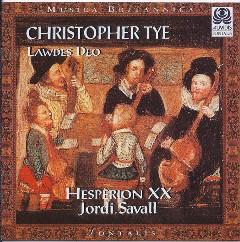Tye - Lawdes Deo (1989)
Tye - Lawdes Deo (1989)

1 O Lux A 5 3:06 2 In Nomine A 4 1:48 3 In Nomine A 5 Weep No More Rachell 2:17 4 In Nomine A 6 2:02 5 In Nomine A 5 Farwell My Good I. For Ever 1:37 6 In Nomine A 5 Rachells Weepinge 2:14 7 Rubum Quem A 5 1:08 8 In Nomine A 5 My Death 2:15 9 In Nomine A 5 Blamles 2:26 10 In Nomine A 5 2:09 11 In Nomine A 5 Rounde 2:25 12 In Nomine A 5 Follow Me 2:07 13 Christus Resurgens A 5 2:50 14 Dum Transisset A 5 I. 3:46 15 Dum Transisset A 5 II. 3:38 16 Dum Transisset A 5 III. 3:50 17 Dum Transisset A 5 IV. 3:35 18 Amavit A 5 2:48 19 In Nomine A 5 Surrexit Non Est Hicc 2:28 20 In Nomine A 5 Free From All 2:09 21 In Nomine A 5 Trust 1:31 22 In Nomine A 5 Beleve Me 2:20 23 In Nomine A 5 Crye 2:01 24 Lawdes Deo A 5 2:12 25 In Nomine A 5 I Come 2:22 26 In Nomine A 5 Re La Re 1:13 27 In Nomine A 5 Howld Fast 1:09 28 In Nomine A 5 Saye So 2:01 29 In Nomine A 5 Seldom Sene 2:06 30 In Nomine A 5 Reporte 1:25 Hespèrion XX: Eunice Brandao, Jordi Savall, Laurence Bonnal, Lorenz Duftschmid, Paolo Pandolfo, Sergi Casademunt
This disc could top the early music charts in any of several categories: outstanding viol consort; best programming; superior engineering. And for sheer aesthetic beauty, it would be hard to find a recording that would score higher on the greater-than-the-sum-of-its-parts scale. Jordi Savall and his Hespèrion XX ensemble pretty much own the viol repertoire, but usually we find them plumbing the works of continental composers from Spain, France, and Italy. Here we find them across the channel in Reformation England in what must have been the very satisfying task of bringing to light the seriously neglected instrumental music of Christopher Tye. Many observers would justifiably argue that although only 31 pieces exist, Tye's music for viol consort represents a summation of the genre--which in its complexities of texture and interdependence of the respective parts is the direct ancestor of the string quartet and other forms of chamber music. Savall and his five colleagues perform all 31 works, most of which are between two and three minutes long and primarily in a contrapuntal form known as In Nomine--a uniquely English creation, popular with many composers, in which a particular section from a John Taverner mass was used as a basis for the whole piece.
The variety and intricacy of the writing is impressive enough, but the richness of the viol sonorities alone gives ample reason to listen to this music over and over. Many of the pieces have a subtitle that refers to a Biblical text or subject of religious significance, and Tye is a master in conveying meaning and mood depending on the theme, from the sobbing, trembling bowing figures in "Crye" and the falling tears in "Rachells weepinge", to the busy, purposeful movement in "Follow me". I learned a new word in reading the liner notes to this recording: sidereal. It means "stellar", and although it was used in reference to O Lux, the first piece on the program, it serves as a perfect description of all of this music and these performances. Don't miss this one. ---David Vernier, ClassicsToday.com
download (mp3 @320 kbs):
yandex mediafire ulozto gett bayfiles








